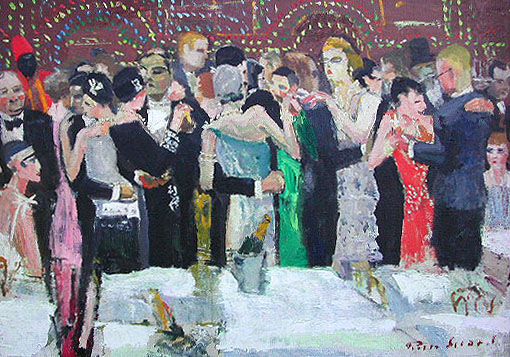Pierre Sicard
1900-1980
Pierre Sicard was born in Paris in 1900, the son of the famous sculptor
François Sicard.
Sicard began sketching when he was 10 years old, even at that young
age his work shows his curiosity with the atmosphere of the nightlife
in dance halls and bars. He did not have any special training in art,
but attended a typical French public school. Later he expressed an interest
in architecture, but gave up his studies to work with some decorators.
He collaborated with his father for a while, and then in 1924 he began
to paint seriously.
Sicard’s style and technique has much in common with the Postimpressionists,
but his subjects were the wild and romantic scenes of Parisian bars
and nightclubs. Sicard’s Paris was filled with jazz scenes, with
black musicians at the Casino de Paris, elegant sophisticates dancing,
confetti flying. He captured the stage performances of Josephine Baker
and Le Revue Négre. His paintings of the 1920’s had titles
like Le Pigalls, Le Dancing, and Charleston; these were “Les Années
Folles.”
Sicard had a long, successful career that spanned more than four decades.
His first exhibition in Paris was in 1924 at Galerie Durand-Ruel. In
1929 and 1930 he exhibited at Galerie George Petit in Paris. One of
his works was purchased for the Musée de Tours.
In 1930 he traveled to London, Marseille, Turin, and Venice. He then
traveled to Spain, and had an exhibition in Madrid in 1931, where one
of his works was purchased for the Museum of Modern Art in Barcelona.
In 1932 he exhibited again in Paris at Galerie George Petit, and one
work was purchased for the Museum of Luxembourg.
In 1934 Sicard spent time working on a documentary film of his own conception,
the subject was the Paris Opera. He spent time later that year in Provence
painting landscapes and in 1935 he exhibited those works at Galerie
Bignou.
Sicard traveled extensively. He visited Hong Kong, Bali, Sydney, Manila,
and in 1936 and 1937 he traveled to the United States. He had an exhibition
in New York in 1936 at the Marie Sterner Gallery. Later in 1936 at Galerie
Bignou in Paris he exhibited scenes of New York.
In 1938 he had an exhibition at Galerie Bernheim Jeune, the preface
of the catalogue was written by Fernand Fleuret. In 1939 he was mobilized
into the army. He was a Sergeant in the Engineering Corps. During the
war he was captured by the Germans but managed to escape back to his
house in Saint-Raphaël. He continued to paint during occupation,
but severe restrictions were put on artists. He managed to exhibit works
from Bali at Galerie Gaffié in Nice, in 1943. In 1944 he was
named the “Official Artist of the War” by the Ministry of
War, in 1945 he worked on tapestries for the French Army.
In 1946 he exhibited at the Galerie Durand-Ruel in Paris, the preface
of the catalogue was written by Florent Fels. This exhibit encompassed
many years of Sicard’s work.
Sicard made frequent trips to New York and Los Angeles, and in 1950
he settled in Los Angeles. He and his wife Suzanne build a house in
Bel Air. In 1951 he had his first exhibition at the Dalzell Hatfield
Galleries, he achieved immediate success, critics praised his paintings
and collectors consumed them. Jean Renoir, the son of the famous painter,
himself a successful film director, wrote glorious things about Sicard’s
paintings. Later that year when Sicard had an exhibition in New York
at Castais Galleries, Jean Renoir wrote the introduction. Sicard also
painted a portrait of Jean Renoir in is house in Beverly Hills.
A year later Sicard exhibited again in Paris at Galerie André
Weil. His works included scenes of Los Angeles and New York, he had
the same exuberance in these painting that existed in his works from
Paris in his early career.
Sicard’s career continued to flourish. He had exhibitions at galleries
in Los Angeles, New York, and Paris throughout the 1950’s. In
1955 Dalzell Hatfield Galleries published a book on Sicard’s work.
Also in 1955 the Los Angeles Country Museum of Art hosted and exhibition
of Sicard’s paintings. Included in that exhibition was a portrait
of Edward G. Robinson on the set of “The Ten Commandments.”
In 1960 the Musée de L’Athénée in Geneva
exhibited Sicard’s paintings, this exhibition included paintings
from every period of Sicard’s life. In 1961 he had an exhibition
in Berne, Switzerland.
In 1963 the Dalzell Hatfield Galleries had an exhibition of Sicard’s
images of Venice, Italy. In 1965 Galerie Durand-Ruel exhibited a selection
of old and new paintings.
Sicard’s paintings are held by many museums, including the National
Museum of Modern Art in Paris, and private collections. One of Sicard’s
paintings hangs permanently at the Carnavalet Museum in Paris, it is
large painting of a nightclub in 1925, titled “Le Pigalls.”
This painting was loaned to an exhibition in 1991at the Montreal Museum
of Fine Arts, the exhibition was called “The 1920’s, The
Age of Metropolis.” By his inclusion in this exhibition Sicard
achieved some measure of his rightful place in the history of 1920’s
Paris, alongside Marcel Gromaire, Tamara de Lempicka, Moïse Kisling,
and Leonard -Tsuguharu Foujita.
|

